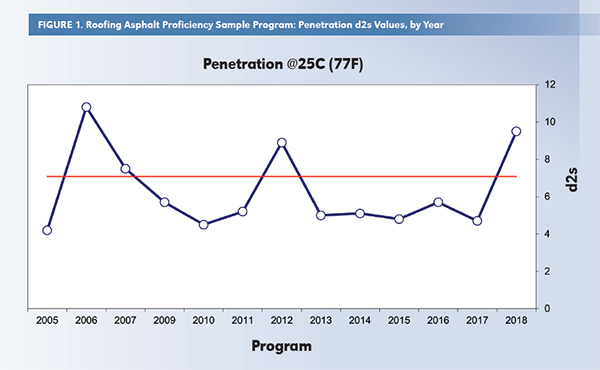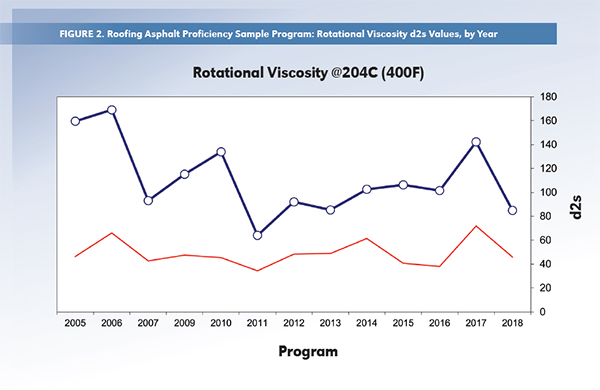Since 2005 the Asphalt Institute (AI) has coordinated a little-known (even in the world of asphalt) proficiency sample program for roofing asphalt binders. The idea started with Paramount Petroleum who coordinated nine round-robin studies from 1999 to 2003.
Those studies focused on four common tests used by labs involved in testing roofing asphalt binders: Cleveland Open Cup (COC) Flash Point, Ring and Ball (R&B) softening point, penetration at 77°F (25°C), and rotational viscosity at 400°F (204°C). In 2004, AI agreed to assume the responsibility of continuing the program.
The first Roofing Asphalt Proficiency Sample Program (PSP) offered by AI was in 2005 and included the same four tests used in the Paramount round-robin studies. Twenty-one labs participated in that PSP. Based on their experience and feedback, AI expanded the program in 2006 to include additional tests including ductility at 77°F (25°C), stain index and penetration at two additional temperatures – 32°F (0°C) and 115°F (50°C).
Although the number of labs increased from 2005 and 2006 throughout the years, the slate of potential tests that a lab could conduct on the roofing asphalt binder samples stayed largely the same. In 2009, AI added the option of conducting Mettler Cup and Ball Softening Point for those labs that performed that test instead of the R&B softening point. The number of labs participating in the PSP increased to a maximum of 44 in 2015 before settling around 30 labs in the past few years.
In 2014, AI added two new optional rheological tests to the slate designed to measure properties at high and intermediate temperatures, corresponding to conventional softening point and penetration (25°C) tests, respectively. For the high-temperature test, the roofing asphalt binder is tested using the Dynamic Shear Rheometer (DSR) at 90, 100, and 110°C with a loading frequency of 1 rad/s. The complex viscosity, η*, is measured at each temperature and used to determine the temperature where η* is equal to 1200 Pa-s. This temperature is expected to correspond to the softening point of the roofing asphalt binder. For the intermediate temperature test, the roofing asphalt binder is tested using the DSR at 25°C with a loading frequency of 2.5 rad/s. The complex shear modulus, G*, is measured and reported. It is expected to correspond to the Penetration of the roofing asphalt binder.
Not as many labs choose to conduct the rheological testing as the standard PSP tests, but by 2018 the optional testing program had increased to 14 participating labs half of the total number of participants.
Why participate in a PSP?
Many labs have found the Roofing Asphalt Proficiency Sample Program to be valuable in assessing how they compare to other labs performing the same tests. Successful programs exist in the paving asphalt industry through proficiency sample programs offered by AASHTO re:source, but not in the roofing asphalt community. Even if many of the tests are the same as those used in some programs for paving asphalt binders, the roofing asphalt binders have different properties and might be expected to have different variability.
As an example, we show graphs of two tests and the results of the calculated multi-laboratory reproducibility, given as d2s, from the 2005-2018 Roofing Asphalt PSPs. The parameter “d2s” stands for “difference two-sigma” and represents the allowable difference between test results reported by two labs to be considered statistically the same. Smaller d2s values mean less variability in the test and greater confidence that two labs performing tests on the same material, in the same way, will get close to the same result. The blue line shows the multi-laboratory d2s calculated from the program of that year. The red line shows the expected d2s value as published in the standard.

In Figure 1, penetration at 25°C (77°F), the red line is horizontal and represents the d2s listed in ASTM D5 for asphalt binders with penetration values less than 60 dmm. The roofing asphalt binders used in the 2005-2018 PSPs had a range of penetration values from 10-25 dmm. As can be seen in Figure 1, the d2s values for each PSP were mostly below the published d2s value of 7.1 dmm. This means that multi-laboratory reproducibility among the participating labs was better (average of 6.3 dmm) than the published value.

In Figure 2, Rotational Viscosity at 204°C (400°F), the red line is not horizontal meaning that d2s is a function of the rotational viscosity value (ASTM D4402). The published value is given as “d2s%” – which is determined as the calculated d2s divided by the average value of rotational viscosity – for unfilled asphalt binders. Unlike Figure 1, the d2s values from the PSPs in Figure 2 (blue line) are consistently above the calculated d2s values using the published d2s% in ASTM D4402 (red line). This means that multi-laboratory reproducibility among the participating labs was worse (approximately 2-3 times higher) than the published value.
What does that mean in terms of changing the published d2s values? For Penetration (ASTM D5) there probably is no change needed. It would be useful to add data from samples with lower Penetration values to see if the d2s could be improved. For Rotational Viscosity (ASTM D4402) a deeper dive into the data is needed. It could be that the labs are performing the test properly, but there simply is more variability inherent in testing roofing asphalt binders at elevated temperatures. It could be that the test conditions need to be tightened to produce consistent results.
Ultimately there are several reasons why a lab would want to participate in a proficiency sample program, even if it is not required:
• Compare results from your lab to other labs that perform the same tests
• Identify equipment or procedural errors in a test
• Improve precision estimates for standard tests and tighten testing procedures
• Evaluate repeatability and reproducibility for new tests
• Track lab performance over time by continued participation in successive programs
If your lab is involved in testing on a regular basis then participating in a proficiency sample program is a great step towards understanding testing variability.
Please contact Gary Irvine (girvine@asphaltinstitute.org) or Mike Anderson (manderson@asphaltinstitute.org) for more information on the Asphalt Institute’s Roofing Asphalt Proficiency Sample Programs.
Anderson is the Asphalt Institute Director of Research and Laboratory Services.













